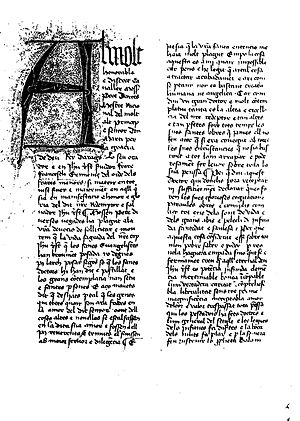Vida de Jesucrist facts for kids

The Vida de Jesucrist (which means Life of Jesus Christ) is a book written in the Catalan language. It was created by a writer named Francesc Eiximenis. He wrote it in Valencia, Spain, probably between 1399 and 1406. Some experts believe it was finished on June 23, 1403.
Eiximenis dedicated this book to Pere d'Artés. Pere d'Artés was a very important person, like a finance minister for the Crown of Aragon. He had also received another book from Eiximenis, called the Llibre dels àngels (Book of Angels). It seems that Pere d'Artés himself asked Eiximenis to write this book in Catalan, not in Latin, which was the original plan. Eiximenis mentions this in the book's introduction.
Contents
What's Inside the Book?
This book is quite long! It has 691 chapters and is split into ten main parts. The last part is even divided into seven smaller sections.
The Vida de Jesucrist belongs to a type of medieval book called Vitae Christi, which means "Lives of Jesus Christ". A famous example of this kind of book is Vita Christi by Ludolf of Saxony. These books are not just simple biographies (life stories). They also include history, comments from important religious thinkers, moral lessons, spiritual advice, and prayers. All of these parts are connected to the life of Jesus, from his birth to his ascension into heaven.
In Eiximenis's book, you can see his deep knowledge from his studies. He even included some ideas from less common sources, like the New Testament apocrypha, which are ancient writings not included in the Bible.
Missing Parts of a Big Project
Like some of Eiximenis's other books, such as the Llibre de les dones, this book contains many topics that were meant for his huge encyclopedia project called Lo Crestià.
The entire Vida de Jesucrist could have been the ninth volume of Lo Crestià. That volume was supposed to be about the Incarnation, which is the belief that God became human in Jesus. However, the Vida de Jesucrist covers much more. For example, its first part talks about predestination, a topic that the fourth volume of Lo Crestià was supposed to cover.
Lo Crestià also planned to explain the seven beatitudes (blessings), and the seventh part of this book does just that. The book also explains two sacraments in detail: baptism, focusing on Jesus's baptism by Saint John the Baptist, and eucharist, about the Last Supper. The tenth volume of Lo Crestià was meant to discuss sacraments. Finally, the tenth part of this book returns to topics about the end of the world, like those found in the Book of Revelation. The thirteenth volume of Lo Crestià was supposed to deal with these very subjects.
How it's Written and What Influenced It
This book clearly shows that Eiximenis's later works focused a lot on contemplation and deep thought. The introduction says the book's goal is to "heat up" (escalfar) believers with love for Christ and devotion to him.
The book also shows a strong devotion to the Virgin Mary, which was common in the Franciscan religious group. Many chapters are dedicated to the Virgin, whom Eiximenis calls the "Glorious" (Gloriosa). It's fair to say that the Virgin Mary is almost as important as Christ himself in this book. This work seems to fit into the tradition of books like the Meditations on the Life of Christ. The Italian Franciscan Ubertino of Casale also influenced this book.
Translations of the Book
The Vida de Jesucrist was translated into both Spanish and French.
The Spanish translation, which doesn't include the last two parts of the book, was made because of Hernando de Talavera. He was a Hieronymite monk and became the first archbishop of Granada after the city was retaken in 1492 by the Catholic Monarchs. He was the confessor (spiritual advisor) to Isabella I of Castille and greatly admired Francesc Eiximenis's work. This Spanish translation was the very first book ever printed in Granada.
Old Editions and Copies
The Spanish translation was printed as an incunabulum (a book printed before 1501) on April 30, 1496. It was printed by German printers Meinard Ungut and Johannes Pegnitzer. This is the only edition of the book that exists today.
However, a scholar named Albert Hauf copied out the first five parts of the book. He added this copy to his special university paper, but it hasn't been officially published yet. This means there isn't a modern, easy-to-read version of this important book available today.
How it Influenced Later Works
The Vida de Jesucrist also influenced other creative works. For example, Josep Romeu i Figueras has shown that a special play about the Assumption of Mary (Mary going to heaven) performed at the Valencia Cathedral around 1425 was directly inspired by Eiximenis's book.
See also
 In Spanish: Vida de Jesucrist para niños
In Spanish: Vida de Jesucrist para niños

